With product promos, email and holiday campaigns, blog posts, and in-person events—often involving multiple teams—how do you keep track of all your marketing activities without losing your sanity?
Maybe you rely on project management tools or hold daily meetings to monitor progress and ensure deadlines are met. But trust us on this: once you try a marketing calendar, you'll never want to go back.
And what is a marketing calendar exactly? What should you include in it? Is it really better than, say, a Kanban board? And how do you create a marketing calendar that becomes a handy and valuable tool instead of another chore to complete? Let’s explore.
What Is a Marketing Calendar
A marketing calendar is a visual tool for tracking your upcoming marketing activities: product promotions, email campaigns, offline and online events, blog articles, social media posts, and collaborations.
In addition to tasks, it can also include important milestones like holidays or seasonal trends, such as Black Friday or Valentine’s Day, that may impact your marketing schedule.
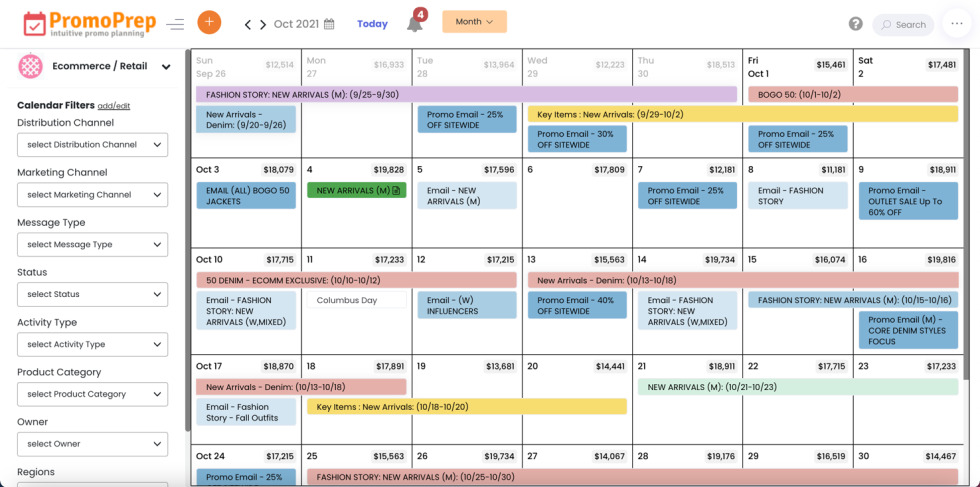
Source: PromoPrep
Types of Marketing Calendars
A marketing calendar is an extremely flexible tool and can be adapted for almost any type of marketing activity. Small teams consisting of only a handful of people—or those focusing on one or two specific areas—can opt for a single marketing calendar combining everything they have to do, including emails, social media posts, and promos. More complex processes may require some fine-tuning, so you might decide to create separate calendars for better task management.
Here are some marketing calendars you can create:
- Editorial/content marketing calendar,
- Email marketing calendar,
- Campaign marketing calendar,
- Advertising marketing calendar,
- Event marketing calendar,
- Holidays marketing calendar,
- Collaboration marketing calendar.
This list is by no means exhaustive. In fact, you can create any type of calendar depending on your needs. The only prerequisites are a task, an assignee for the task, and a deadline you don’t want to miss. While the idea of creating a single meta-calendar for everything may seem appealing, activity-based calendars can be equally useful. A dedicated project calendar helps you and your team stay focused and maintain a clear vision of the timeline and scope of work.
So, let’s say you see the potential for creating a marketing calendar—what are the benefits?
The Benefits of Keeping a Marketing Calendar
Straight off the bat, the first and most important benefit is peace of mind. A visual board with all the tasks for the upcoming month (quarter, or year) gives you a confidence boost and dramatically reduces stress. But it’s not the only perk:
🚀Meeting deadlines
Many deadlines are missed simply because you don’t realize how little time is left before it’s too late. A carefully planned marketing calendar helps you gauge the timeline more accurately and stay ahead of it.
🚀Effective prioritization
There may be a couple of dozen tasks in your backlog, but a calendar keeps priorities clear, allowing you to focus on what’s most urgent. Tip: color-coding activities by larger projects and goals is a great way to remind yourself why each task matters.
🚀Easier team management
A marketing calendar helps synchronize your team’s work, ensuring everyone sees what’s coming next and can adjust accordingly. It also helps avoid overwhelming team members with multiple deadlines falling on the same date. When conflicts arise, you can quickly identify and resolve them before the assignee becomes stressed and confused by an insurmountable workload.
🚀Enhanced collaboration across teams
A shared calendar ensures everyone is on the same page—not just within your team but across departments like sales, design, or development. When plans shift, you can quickly adapt and make the necessary changes.
🚀Better strategic planning
An overview of seasonal and industry events, as well as business goals like product launches, simplifies long-term planning. You can identify gaps and opportunities and prepare in advance, maximizing the impact of your marketing efforts.
🚀Creative boost
Poor planning often leads to rushed decisions and resorting to the same old tactics—even if they don’t work as effectively anymore. In contrast, when your team has ample time to prepare, brainstorm, and experiment, you can explore new channels, content formats, and lead-generation strategies, like creating an interactive Christmas catalog to boost your end-of-year sales. This results in more impactful campaigns and faster business growth.
What to Include in a Marketing Calendar
We’ve already mentioned some key things to include when discussing types of marketing calendars, but it doesn’t hurt to expand the list.
Depending on your goals and activities, consider including:
- Holidays and seasonal trends,
- Important industry events (e.g., tradeshows, awards, conferences),
- Product or service launches,
- Internal events (e.g., brainstorming sessions),
- Various marketing activities (emails, blog posts, social media posts).
For specific tasks, it’s a good idea to include the assignee, marketing channel, project description, task status, and, sometimes, the budget. Links to relevant resources like content copy, design, or checklists can also be helpful.
This way, you’ll keep everything organized, enhance team accountability, and improve internal communication.
Not sure if you’ve included everything worth adding? Chat with colleagues in product, sales, or design—they might spark fresh ideas or point out something you’ve missed.
How to Create a Marketing Calendar
Looking at those beautifully planned, complex calendars can feel overwhelming, but breaking the process into smaller steps makes it totally manageable. Here’s what you need to do to create a marketing calendar from start to finish.
#1 Identify key events and dates
At this step, you just write down the biggest milestones for the upcoming year and mark the dates. Don’t be afraid to be bold. Even if plans change or get postponed, you can always do that later with no harm done to anyone. Yet, marking a few important objectives—be they product launches, live events, or collaborations—will help you not to lose sight of the bigger picture in the daily routine.
#2 Identify your focus points
Next, decide what you actually need in your calendar. Maybe, you want to avoid overlapping schedules on a specific marketing channel? Don’t forget to add a “Channel” field. Want to better understand how the tasks are spread across your team and who’s responsible for what? Then an “Assignee” tag is a must.
In other words, now it’s time to ask yourself—what is the main thing you want the marketing calendar to help you with? The answer will easily point you in the right direction.
#3 Set the schedule
Once all the key events fall into place, you can zoom in on your nearest tasks and start shaping out timelines. At this point, it doesn’t make sense to meticulously plan everything until next January. Take the next quarter or even month and identify the touchpoints you’ll need to set your team for success.
Maybe, you’ll need to collaborate with other teams to create deliverables, or some assets like ebooks or videos are missing and must be prepared beforehand. Assess the time needed to get everything ready by the date X—and here you go, you’re almost done.
#4 Select your marketing calendar tool
Gone are the days of calendars drawn on whiteboards—though you can still make one if that’s your thing! However, in the age of remote working and state-of-the-art technology, the choice of great digital tools is almost infinite. You’ll find a few recommendations from us below.
Marketing Calendar Tools
Before diving into concrete tools, here’s a quick checklist to help you pick the marketing calendar that works for you:
- Customizable: So you can fine-tune it to your goals and activities.
- Easy-to-use: An intuitive interface will ensure you’ll stick to it, and the calendar will actually be used—which is the key to the success of the whole endeavor.
- Shareable: A calendar will only work if all the people involved can use it and synchronize their work.
That said, let’s name some names.
Google Sheets/Microsoft Excel
Google Sheets is a perfect starting point if you aren’t ready to invest in more complex and costly tools. It provides all the core functionality like multiple data formats, filtering, color-coding, and linking to different assets. It’s also pretty intuitive and easy to grasp, considering the fact that there are very few people in today’s day and age who have never worked with Excel or Tables before.
On top of that, there are multiple marketing calendar templates available to spare you a few hours of building the calendar from scratch, so you can set up your new calendar in no time.
Here’s a marketing calendar example created in Google Sheets from SemRush.
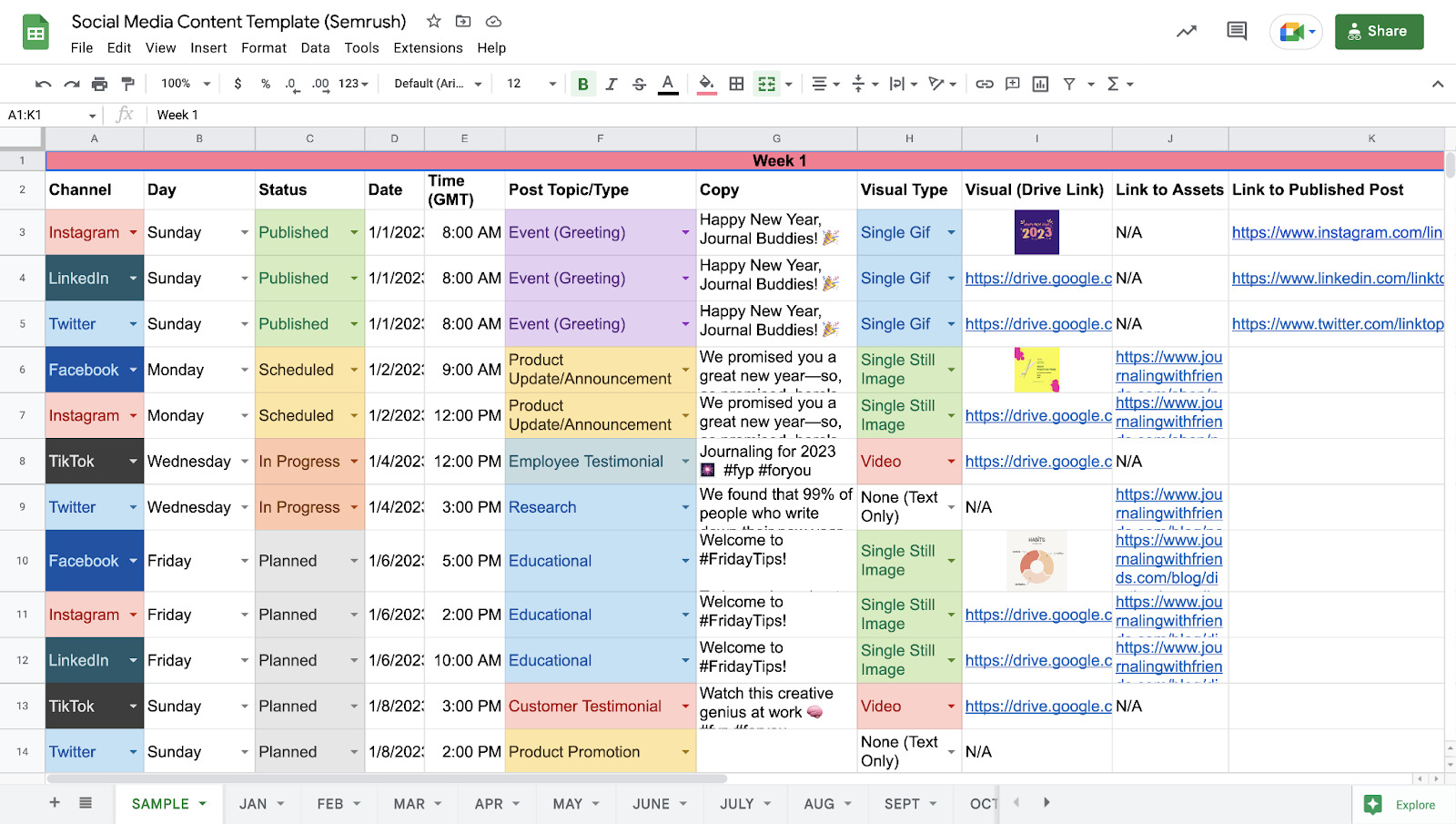
Source: SemRush
Trello
Trello is hands down one of the easiest tools for organizing your marketing plans. You can use it as a visual to-do list with cards you can move around as things evolve, and change the view to a list, board, or calendar—according to your current needs. What sets Trello apart is how customizable it is: you can add due dates, labels, and even checklists inside each card.
As with Google Sheets, there are hundreds of nice marketing calendar templates to choose from. Some of them are created by such industry experts as Dropbox or Wired, so you can tap into their experience before figuring out the best way for you to organize things.
Plus, you can synchronize it with your personal calendar to always stay on top of your tasks and keep everything under control.
Here’s an example of a content marketing calendar made in Trello:
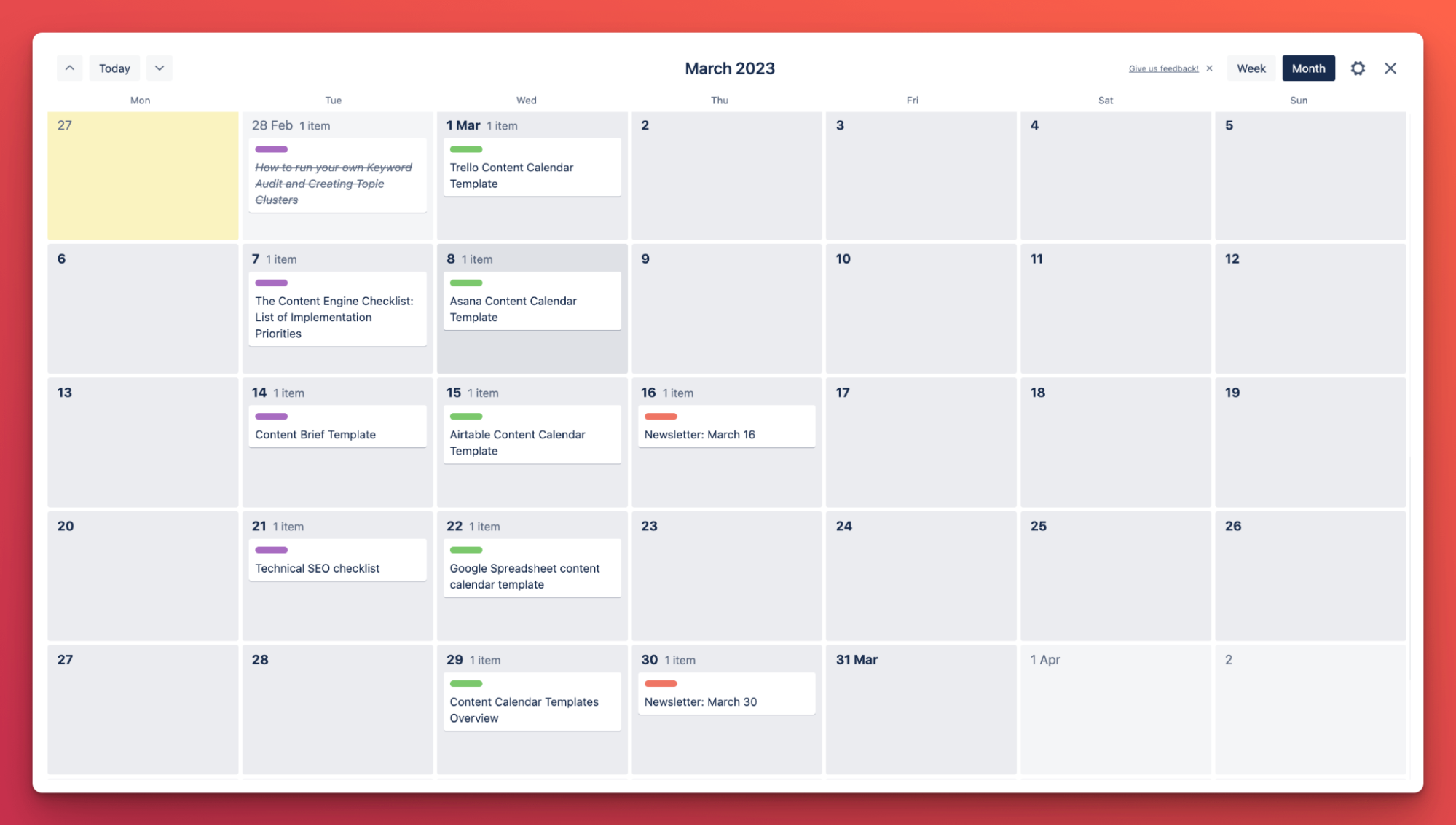
Source: thisisgoodmarketing.com
ClickUp
ClickUp is another solid option for keeping track of marketing activities. You can assign tasks, add customizable statuses and watchers, and turn the calendar view into a Kanban board or a Gantt chart if needed.
ClickUp also supports integrations with other marketing tools like Slack, Zoom, and Google Calendar, which helps keep everything and everyone connected and boost productivity.
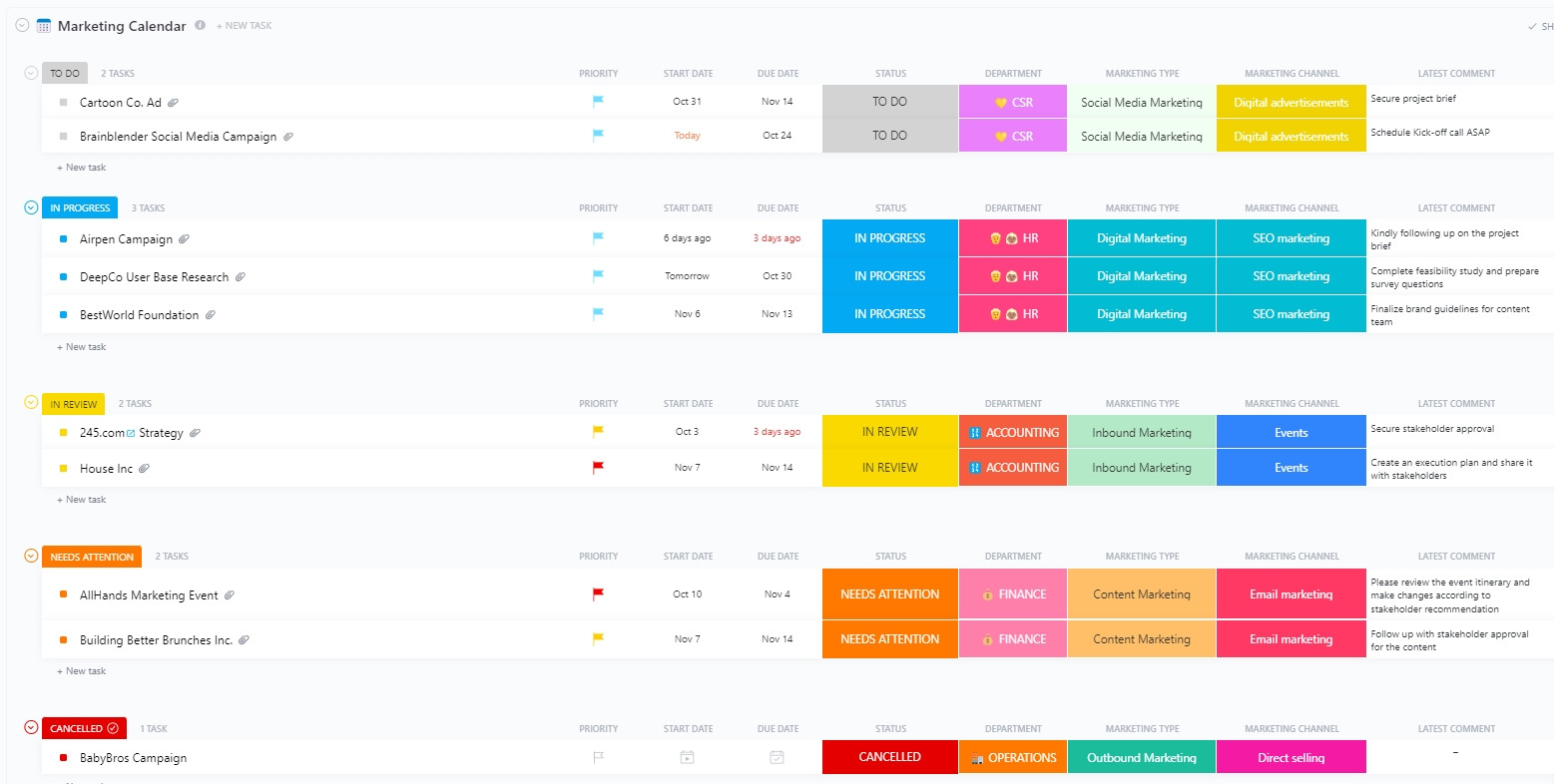
Source: ClickUp
CoSchedule
CoSchedule is a handy tool designed specifically with marketing teams in mind. Its marketing calendar integrates seamlessly with your other workflows, allowing you to schedule and track tasks, campaigns, and content all in one place.
Just like ClickUp, CoSchedule integrates with popular tools like WordPress, Google Analytics, and social media platforms, making it a great choice for teams looking to simplify their marketing efforts without switching between multiple tools.
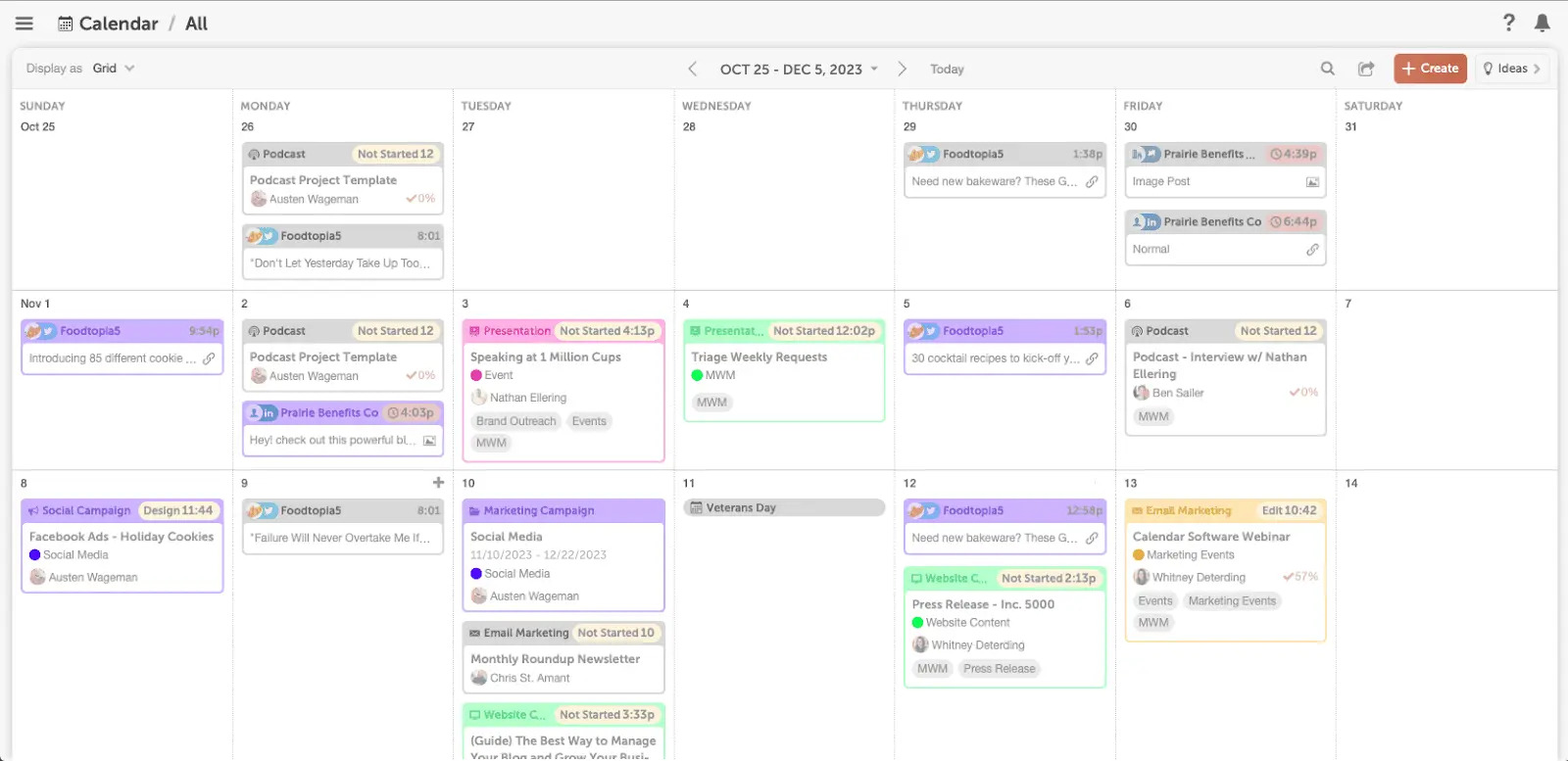
Source: CoSchedule
HubSpot Calendar
A powerful CRM and a versatile marketing tool, HubSpot definitely understands marketers’ needs. Its calendar is an easy-to-use tool especially useful for those who are already familiar with the platform. This way, you can keep track of all your activities in one place and avoid juggling a million spreadsheets or emails. Create tasks for your most common activities, see their status, check out the tasks for the day, or get a bird's view on everything planned for the month—and stay productive.
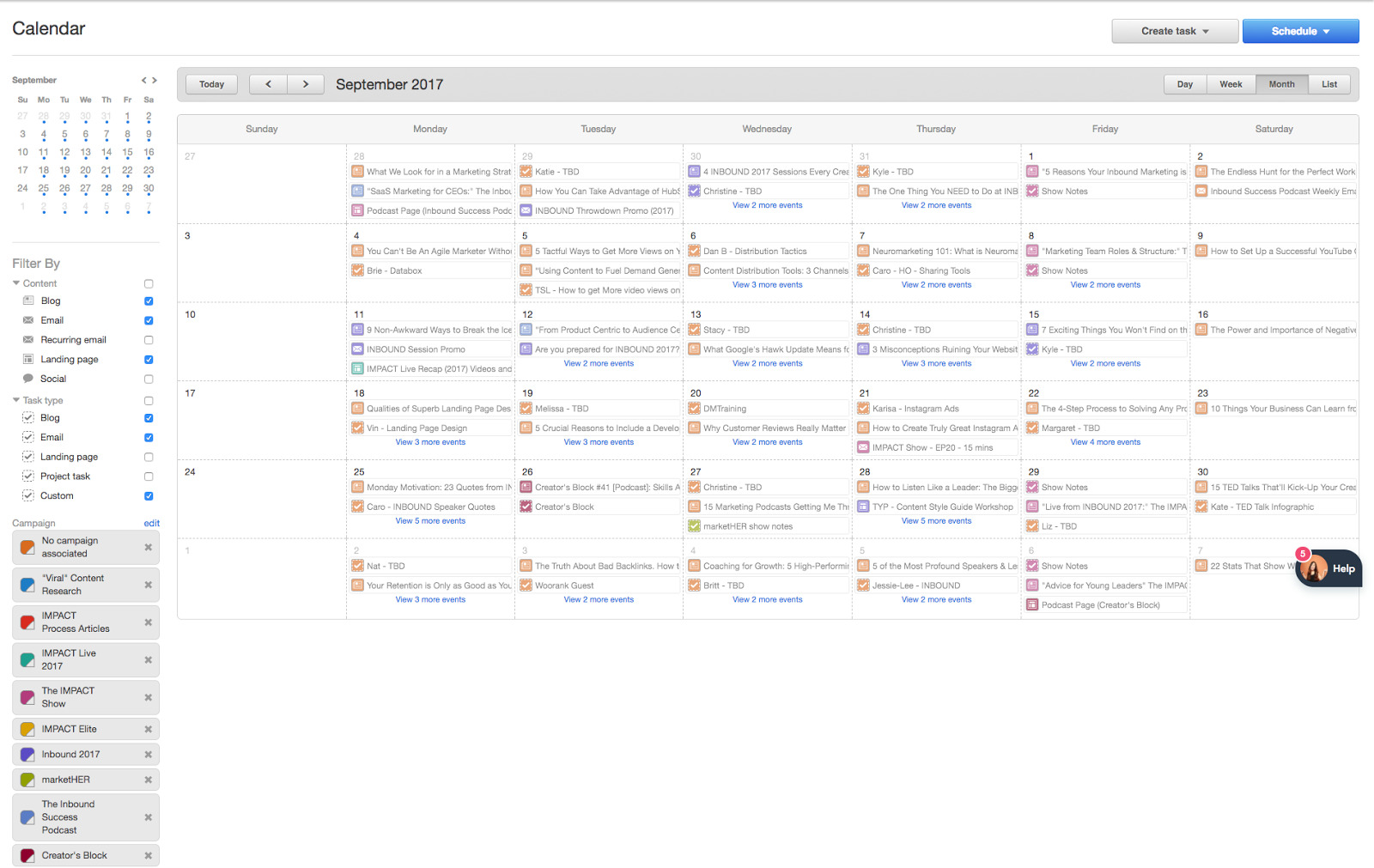
Source: HubSpot
It should be noted that almost all marketing management tools offer a Calendar view alongside a list of tasks or a board. So, if you are looking for a marketing calendar tool, the easiest way is to explore the capabilities of the platform you’re already using. Chances are, you already have what you need!
Bonus: Boost Your Productivity Further with Digital Docs
Now that you’ve got your calendar set up, here’s one more tip to keep your marketing organized and effective. Keeping track of tasks is important but so is providing your team with assets and resources that are timely and readily available.
If you often attach lengthy PDFs to your marketing tasks, consider turning them into interactive digital documents. FlippingBook can help you transform any document—be it a brochure, presentation, newsletter, or guide—into a flipbook available as a link or an embed. Like the one here:
Global Marketer's Calendar 2023
On top of all interactive presentation perks like video and GIF adding, docs like that are much easier to update. No matter how many channels you’ve posted the link to, you can simply re-upload the document on your side—and everyone will get the latest version. No need to resend anything.
Do you often craft sales proposals and brochures? Your sales team will love the new format! Here’s how FlippingBook transformed account marketing for a major data privacy client.
Final Thoughts
Creating a marketing calendar is a great investment into a more organized, stress-free workflow, so we encourage you to try it! And hope this article helps you make an actionable marketing calendar that will become an indispensable tool in your kit.





